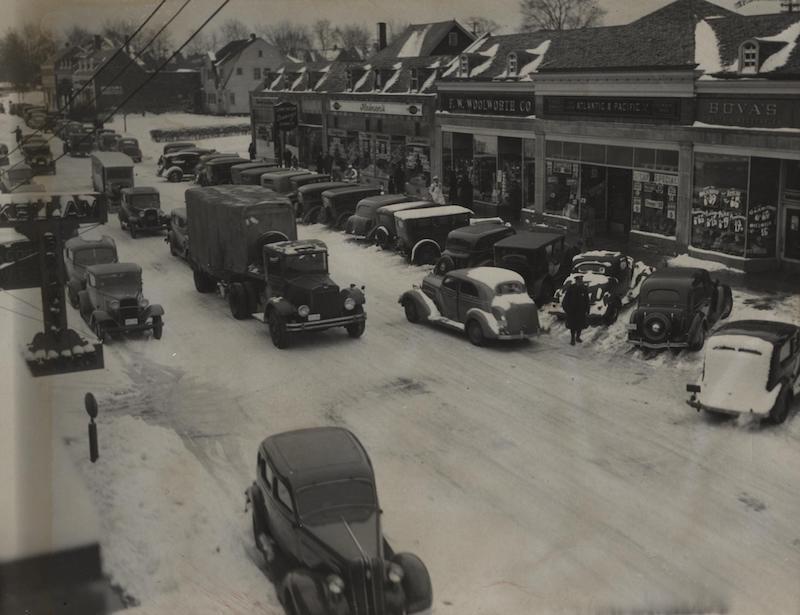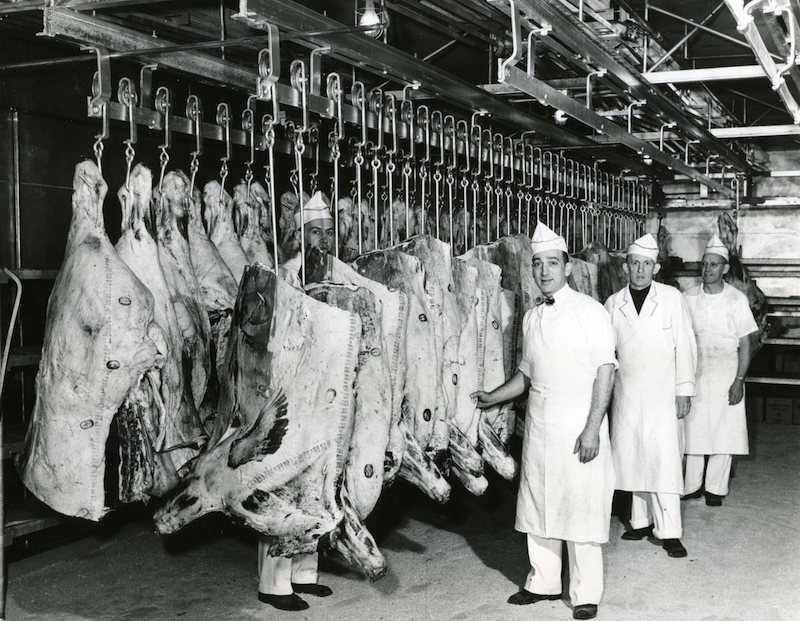
Heinen's Fine Foods grew from within the bustling Kinsman-Lee commercial district to become both a revered neighborhood institution and a thriving supermarket chain with stores located throughout the Greater Cleveland area. With origins as a small storefront butcher shop in the Kinlee Building, the story of Heinen's Fine Foods is intertwined with the history of a flourishing commercial district at the intersection of Kinsman and Lee Roads.
The northeast quadrant of the Chagrin Boulevard and Lee Road intersection sat empty in the winter of 1990. The only remaining structures along Chagrin Boulevard between Lee and Avalon Roads were Shaker Hardware and Heinen’s Grocery Store at the eastern end of the lot. The two businesses had been selected to anchor a ten-million-dollar redevelopment project of Shaker Towne Center initiated by the City of Shaker Heights. Both had ties to the Kinsman-Lee community dating back to the intersection’s early development as a retail hub for the growing populations of Lomond and Moreland neighborhoods. While Shaker Hardware would stay at its present location, Heinen’s, Inc., was to move just west of its 23,000 square foot building into a 43,000 square foot supermarket. An aisle of parking for the new site sat directly north of the grocery’s place of origin at 16621 Kinsman Road (now Chagrin Boulevard). Once a small storefront butcher shop, the business grew within the bustling Kinsman-Lee commercial district to become both a revered neighborhood institution and a successful grocery chain with supermarkets throughout the Greater Cleveland area.
As recounted by business founder Joseph H. Heinen in the 1950s, the beginnings of Heinen’s Grocery Store can be traced back to 1929 at the northeast corner of the Kinsman-Lee intersection in Shaker Heights. The German immigrant had worked at butcher shops in Cleveland since his youth, including seven years at Dedreux Market Co. stores. Following a heated disagreement with a boss, Heinen quit his job and opened a small meat market on Kinsman Road. Heinen’s timing and choice of locations proved key to his success.
Sustained by rapid population growth in the southwest region of Shaker Heights, both land speculators and business owners prospered in the Kinsman-Lee district. The site was previously designated for commercial development by the Van Sweringen Co., and businesses operated out of homes east of Lee Road along the north side of Kinsman Road during the early 1920s. A lot with 212 feet fronting Kinsman Road and 203 feet on Lee Road had sold in 1922 for $29,000. The purchaser sold the land soon after to a group of investors for $40,000, which in turn sold it in 1924 to the H. A. Stahl Company for $70,000. The property was once again passed on for around $90,000 to the Union Trust Company, which immediately leased the corner for ninety-nine years to the Kinlee Company. A purchase option was offered at $110,000, effective from 1929 to 1939. The Kinlee Company demolished the existing homes and erected a commercial building at a cost of $75,000. Twelve storefronts comprised the new building. Upon opening in March, 1926, all spaces had been subleased. With similar speculation occurring on the northwest corner of Kinsman-Lee, the Cleveland Plain Dealer noted that the “two corners of Lee and Kinsman roads afford two of the best illustrations of the money to be made in Greater Cleveland land investment.”
Cleveland newspapers reported the quick leasing of all business spaces in the commercial district through the time Heinen set up shop in 1929. The Great Atlantic & Pacific Tea Co., Cleveland’s largest merchandising chain, announced that their Kinsman-Lee branch was the busiest of nearly 500 regional stores that year. Listed as 16621 Kinsman Road in the 1930 Cleveland City Directory, plat maps place Joseph Heinen’s butcher shop at the eastern corner of The Kinlee Building. Dedreux Markets Co. also moved into this structure in 1929. Heinen would later reflect on these early years operating the store: “It amazed me. I didn’t expect to do as well. I think the section had a lot to do with it. It was a very fertile spot.”
By 1931, stores extended along the east side of Lee Road between South Moreland (now Van Aken Boulevard) and Kinsman Roads. Six hundred feet east along the north side of Kinsman Road also housed commercial structures. Development quickly moved to the southern side of Kinsman Road, attracting many of the businesses housed in the Kinlee Building’s small storefronts. Six storefronts and 12 offices opened in a new structure at the intersection of Kenyon, Lee and Kinsman Roads in 1933. A building permit for 16708 to 16710 was filed in July 1933. A block structure connecting the two buildings opened its doors in November 1935. At that time, all spaces had been leased. Both the Dedreux Market Co. grocery and Great Atlantic & Pacific Tea Co. relocated to the new block building, which also housed a Woolworth Co.
Joseph Heinen was among the new tenants on the south side of Kinsman Road. His small butcher shop, having earned a reputation for cleanliness and high-quality products, was thriving amidst an economic recession. Looking to expand, the entrepreneur relocated to a double storefront at 16708 and 16710 Kinsman Road. The new store, however, would offer more than just meat. Responding to demands of customers for additional products, food options such as canned goods, seasonal vegetables, and peanut butter were offered. This mixture of salable items was unique within the Kinsman-Lee shopping district, and marked the beginnings of Heinen’s Grocery Store. The deed for the property was transferred to Joseph Heinen in 1936.
The grocery continued to grow at the double storefront in the Kinsman-Lee neighborhood through midcentury. During this time, Joseph Heinen began early efforts to expand as a chain in Cleveland’s affluent suburbs. New stores in Cleveland Heights and Shaker Square opened in 1939 and 1950, respectively. The Kinsman store would once again move in 1953, relocating to 17021 Kinsman Road. Nearly occupying the entirety of a city block, the modernized space offered both a large parking lot and interior designed for customer convenience and comfort. These new features guided the future character of Heinen’s chain of stores. Walls were painted in soft colors, with special attention paid to the accessibility, presentation and lighting of the store’s goods. Check-out conveyors were equipped with ‘magic eyes’ to speed up the cash register process, and a policy of parcel pickup service was implemented where attendants loaded groceries into customers’ vehicles.
A period of rapid expansion followed. Eleven supermarkets and a distribution warehouse would be opened throughout the Greater Cleveland area between 1953 and 1990. In 1987, the City of Shaker Heights announced its plans to completely overhaul the Kinsman-Lee commercial district. As one of the few areas zoned for commercial purposes, economic growth in the district was critical to providing tax revenues in a predominately residential city. While not in disrepair, the area faced increased competition from malls in Cleveland’s eastern suburbs.
Prior to redevelopment, the Kinsman-Lee district had three supermarkets, three gas stations, four delicatessens and numerous specialty shops. Characterized by its many specialty shops, the recently branded Shaker Town Center lacked a strong anchor store, unified management, convenient parking and a cohesive identity. Despite strong opposition from business owners, the public showed support for the City-sponsored project by voting down an alternate redevelopment plans that would have placed revitalization efforts in the hands of multiple private developers.
Early plans for Shaker Towne Center centered on building a 40,000 square foot upscale supermarket, which would be complemented by a drug store, a bank and a variety of retail shops. All office spaces would be removed. The City acquired the land and then sold it to Chase Properties for development. Heinen’s, Inc. was selected to be the anchoring supermarket. The company agreed to sell their current building to the City, and lease the proposed shopping center at the heart of the development. During the winter of 1991, Heinen’s relocated to its new home at the intersection of Chagrin Boulevard and Lee Road. Once a tiny butcher shop, the family owned supermarket had grown from within the Kinsman-Lee commercial district to become both an integral component of the neighborhood’s commercial identity as well as a thriving regional supermarket chain.
Images











